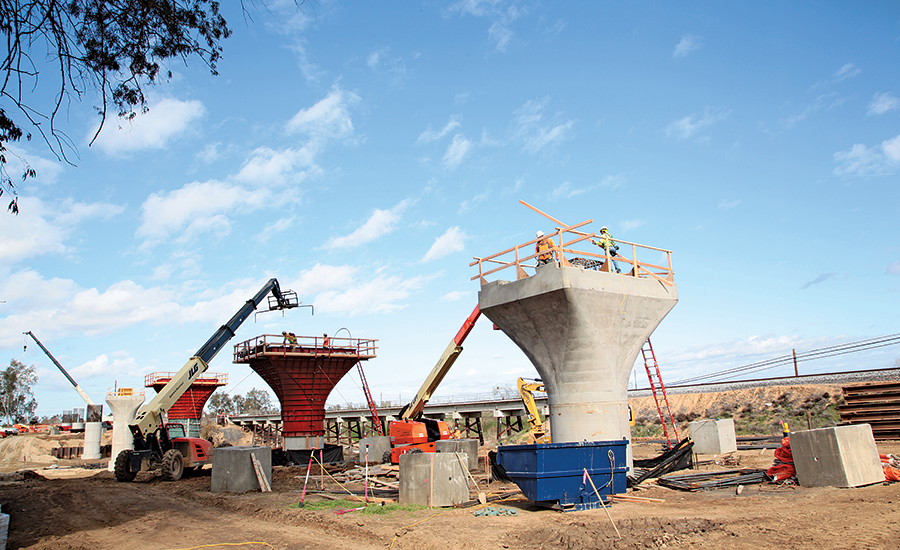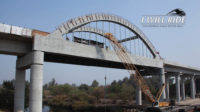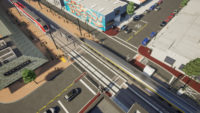As the California High Speed Rail Authority executes multiple contracts for California’s $62.1-billion high-speed-rail line, crews are making headway on the initial 100 miles of track. The efforts comprise a scaled-back initial plan of operation, between San Jose and north of Bakersfield, which could begin carrying passengers by 2025.
Construction commenced last summer on the $985-million Package 1 to build 29 miles of track in Madera and Fresno counties. After about two years of preconstruction, design-build joint venture Tutor Perini/Zachry/Parsons (TPZP) began work on the Fresno River Viaduct in June. The structure is just one of 52 overpasses to be built in the rail line’s first three construction packages.
Support columns for the 1,600-ft-long viaduct section needed to be “supersized,” compared to a traditional roadway overpass, because they have to remain stable under the weight of an electrified train traveling at speeds of up to 220 mph, says Whitey Gregory, structures manager for TPZP. Crews place the 12-ft-wide columns—with bent caps that flare to 17 ft, 6 in.—at approximately 100-ft intervals.
The TPZP team opted to prefabricate the 24-ft wing frames to support the railbed in the staging area and then forklift them into place. “It takes more time in the beginning, but it should make it easier as we go,” Gregory says.
Also under construction is the first of two bridges carrying one-way traffic into downtown Fresno. Crews demolished existing overpasses in sections, using a false deck to catch debris. Crews proceeded slowly because the work had to stop every time a train passed, says Toni Tinoco, information officer for the authority.
The first columns are being poured for a higher overpass that will allow for two-way traffic. “This will improve flow to the downtown while preserving the downtown businesses,” Tinoco adds.
In January 2015, Dragados-Flatiron Joint Venture (DFJV) won Construction Packages 2 and 3, with a bid of $1.2 billion for 65 miles in Tulare County. DFJV immediately started utility relocation, surveying and clearing to make way for construction.
Crews demolished 8,000 tons of asphalt and concrete to make way for rail line and infrastructure. All the material will be recycled for the project or elsewhere.
The DFJV team proposed replacing portions of the planned concrete viaduct with earthen embankments, lowering the profile of the train and eliminating a number of crossings—a strategy that reduced the need for some 550 acres of right-of-way.
Additionally, the team revised designs by lowering a proposed station in Hanford from 60 ft high to at-grade. It created some challenges. For example, a half-mile of state Route 198 and two miles of Union Pacific track will be trenched some 30 ft, but DFJV says the change will save $130 million and a full year of construction time. “The lower profile also enhances the performance of the station in the agricultural setting, making it more convenient for passengers to access the trains,” says Lloyd Neal, project director at Dragados-USA.
California Rail Builders in March won Package 4, with a bid of $348 million for 22 miles in Tulare County. CRB immediately began working to secure right-of-way.
Since the high-speed-rail line cannot include at-grade crossings for safety reasons, 55 freight rail-grade separations will be constructed in the Central Valley, where the corridor parallels freight lines.
Other safety measures include quad gates and positive-train-control intrusion detection along blended corridors. A warning system will be used to detect earthquakes before they happen and automatically stop trains in case of a significant seismic event.
To speed up construction starts, the California High Speed Rail Authority brought on more personnel to negotiate and streamline contracts. In the future, the agency will release RFPs once funding and environmental approvals are in place, with an emphasis on tunneling contracts, due to their longer construction time scales, according to Alan Glen, director of real property, in a board meeting presentation. As of Jan. 29, the authority has acquired 642 of the 1,468 parcels needed for the first three construction packages. This amount was considered “critical mass” for moving forward.




